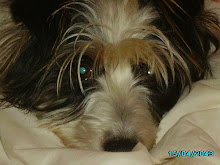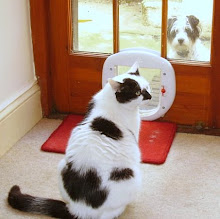
Debs has kindly passed on this award to me. There are a few rules that come attached to it:
1. Every winner of the Prolific Blogger Award has to pass on this award to at least seven other deserving prolific bloggers.
2. Each Prolific Blogger must link to the blog from which he/she has received the award.
3. Every Prolific Blogger must link back to This Post, which explains the origins and motivation for the award.
4. Every Prolific Blogger must visit this post and add his/her name in the Mr. Linky, so that we all can get to know the other winners.
Got that?
Well, rather than choose, I nominate the next seven people who comment on this post - I'm frantically trying to get everything done before we go on holiday on Friday so excuse my cheating. Will be back in about 10 days time.
And I leave you with a piece about Canine Bowen Therapy, a little known treatment available to all our doggie friends. In March Cornwall Today.
USING HUMAN TECHNIQUES TO TREAT YOUR DOG
Many people in Cornwall combine several jobs, but it's refreshing to find someone who really enjoys several very different careers. Frances Carter, 47, has run the Hibiscus (women's) Surf School in Newquay for the past 7 years, has been a complementary therapist for the past 25 years and is a lecturer at Truro College. “I'm a sports therapist,” she says cheerfully, as she sits on her kitchen floor making friends with Mollie Dog. “I treat animals and humans, and I teach complementary therapy on the Foundation Degree course. I do the surfing in the daytime and the rest in the evenings.”
While combining complementary therapy and surfing might seem a strange combination to some, for Frances it makes perfect sense. “Surfing is one of my passions and complementary therapy the other, so that's where the balance comes in.”
Frances trained as a human Bowen therapist and became interested in using these techniques to help animals. “I used to do complementary therapy on my dog and I've often thought that dogs are much more in tune with their own bodies than humans are, so that makes you more in tune as well,” she explains.
The Canine Bowen Technique is one of the fastest growing complementary therapies in Britain, based on the principles of the Bowen Technique developed by Australian Tom Bowen (1916 – 1982). Its adaption in the UK for use on dogs was started in 2001 by Bowen therapists Sally and Ron Askew, who integrated it into their own dog behavioral and rehabilitation work. In 2003 they founded the European Guild of Canine Bowen Therapists and designed a professional programme of training.
“My training took just over a year and covered five modules,” says Frances. “Anatomy and physiology (taught by a vet), nutrition, behaviourism and dog psychology, and throughout we were learning the actual techniques, with an exam at the end. I've also done an OCN level in Companion Animal First Aid which was taught by a local vet, and I'm fully insured.”
For any vets uncertain of her qualifications, Frances is quick to reassure. “Canine Bowen therapy is regarded as manipulative therapy covered by the Veterinary Surgery (Exemptions) Order 1962 of the 1966 Veterinary Surgeons Act, allowing qualified practitioners to work on animals who have been referred by the animal's vet,” she says.
She also points out that Bowen works in conjunction with, never as an alternative to, proper veterinary care. “All dogs must be thoroughly checked over by their vet, and get their vet's written approval prior to starting a Bowen session,” she says firmly. “I am not a vet, so I would never diagnose an animal, nor would I ever prescribe or alter any medication. This is purely a complementary therapy which has been deemed by vets to help dogs.”
While some vets are unsure about Bowen Therapy, Frances worked very closely with her local surgery. “I've got a really good relationship with my vet who's supported me 100% ,” she says. “We've also written a first aid course together.”
At first her vet didn't understand how Bowen works, so Frances had a practical solution. “I treated his dogs and then I did him because he didn't understand why one minute his dog was a snappy terrier and the next minute was asleep in its cage! After treatment he had a much better understanding of how the dogs felt.”
Bowen therapy is an holistic therapy “which means we do a thorough observation looking at the dog's daily life, background, medical history, diet, exercise profile and how it's handled,” Frances explains. “A dog may be brought in with, say, rear-leg lameness, but I may well treat other parts of the body as well, such as the front-legs, in order to sort out other possible problem areas caused as a result of the dog compensating for the problem.”
The actual hands on therapy is a very light touch in specific places that's adapted from the human Bowen Technique. “We know that there are millions of sensory nerve endings on the skin and these light touches send a disruption through the central nervous system that can help the body rebalance itself,”she adds.
The benefits are many and various. “It can help encourage a greater range of movement,” Frances says. “It can also help a dog be pain free or at least reduce pain.” She has treated dogs for all kinds of problems, from ear infections to hip displasia and even tennis elbow! “Ear infections are usually due to an imbalance in the immune system,” she explains. “I've also treated re-homed dogs from the RSPCA – if they come from kennels and suddenly go into a home environment then the dog can have a lot of problems, particularly if there' s already a dog in the household. If a dog is highly stressed, Bowen can give it better quality rest because it makes them very relaxed.”
She has found that dogs seem to know instinctively where they need to be treated and when they've had enough. “When a dog's had a treatment and they trust you, they often come back and give you a paw or whichever part of the body they want done!” she says. “As humans, we're told what's the matter with our bodies – dogs have no preconceptions, so they're much more in tune with their bodies, as we were hundreds of years ago.”
A session usually lasts about 45 minutes, though the hands-on treatment usually takes around 20 minutes. Before the session, Frances needs a signed veterinary referral form, and will ask for a detailed medical form to be filled in. “I like to know everything about the dog because sometimes when owners fill the form in they often realise other factors that might contribute to the dog's condition,” she explains. This information helps monitor changes between treatments and gauge how the dog is progressing. Therapy is not forced upon the dog, and the dog is not restricted at any time during the treatment.
An initial session costs £25 for the first session and £20 for sessions thereafter; travel charges are 30p per return mile after 15 miles. The number of sessions needed depends on the dog and its reaction to the treatment. “With some dogs you see a change in the first session,” Frances says. “Usually you see some sort of change in the second or third treatment, but it's never a cure; it's aimed at helping the dog in the way it needs.”
Seeing how Mollie reacts with Frances, it's evident that animals trust her, which makes her work very rewarding. “I love working with animals more than humans because you see such dramatic effects and it's lovely when you can help the dog,” she says. But she also finds working alongside a vet very interesting. “My vet said that we pick up so much more than they can during a consultation because they only have a few minutes with the client,” she says. “I always write a report back to the vet after a treatment so the vet can see what I've found and that can change the way he treats the animal.”
Frances has been working with dogs and horses for over 28 years and has competed with both at championship level: she shows her own Newfoundland, Douglas, at Crufts. “Equine Bowen therapy is much more established because of racehorse owners and stud farms,” she says. “More and more vets are coming on board and scientific research is being carried out on the human Bowen technique, so hopefully it will eventually be more widely recognised.”.
And looking ahead? Frances smiles at her huge Newfoundland, Douglas, making friends with diminutive Mollie. “I would like to see Canine Bowen Therapy available at vets as a complementary therapy to help the likes of firework fear,” she says. “Personally, I aim to continue improving my knowledge and skills in both human and canine therapies.”
01637 879374 or 07810 6428981
info@hibiscussurfschool.co.uk.
















11 comments:
Congrats on the award, I'll pass on it if you don't mind too much.
Where are you off to Flowerpot?
Congratulations on the award FP, and have a lovely holiday.
Ak - I'd be very glad if you did. We're off to Fowey but my brother in law will be here looking after the cat!
JJ - many thanks m'dear!
Hope you have a wonderful trip. I've heard Fowey is very beautiful, but have never been there.
Debs - it's well worth a visit I can assure you!
Have you ever seen the Dog Whisperer? Huge show here in the states. I like the way Cesar relates to animals. He doesn't believe they're human; he recognizes they're animals. But he understands what makes them tick; how to relate where the animal feels safe and loved; how to give them exactly what they need. To me it's better than treating them like a human because it provides the animal with exactly what they need and not a human's interpretation.
Loved the post.
Lovely award you've got there, FP, and well deserved too!
Sandra - yes I ghave seenthe dog whisperer, and interviewed his Cornish equivalent! Fascinating how they work isnt it?
Liane - thanks for that!
Hi,
Thanks for the information about this Really nice Post..
emotional Freedom Technique
shoulder pain
back pain
confidence building
Post a Comment